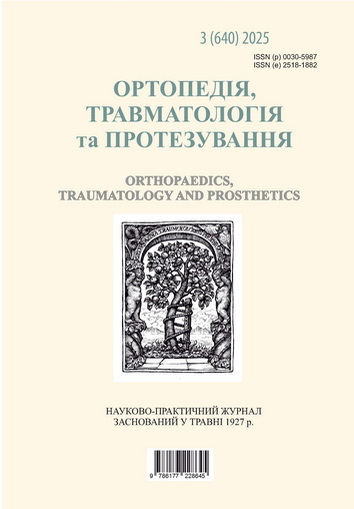THE EFFECT OF CARBOXYTHERAPY AND ITS COMBINATION WITH DICLOFENAC SODIUM AND CHONDROITIN SULFATE ON TNF-Α AND TGF-Β1 EXPRESSION IN MONOIODOACETATE-INDUCED OSTEOARTHRITIS IN RATS
DOI:
https://doi.org/10.15674/0030-59872025384-90Keywords:
Оsteoarthritis, carboxytherapy, CO2, diclofenac sodium, chondroitin sulfate, TNF-α, TGF-β1, experimental model, monoiodoacetic acid, combined treatmentAbstract
Osteoarthritis remains one of the leading causes of disability worldwide, associated with chronic inflammation and progressive destruction of articular cartilage. Current therapeutic approaches show limited efficacy in restoring damaged tissues, which drives interest in novel adjuvant methods, particularly physiotherapeutic techniques such as carboxytherapy. Objective. To investigate the effects of carbon dioxide monotherapy and its combinations with diclofenac sodium or chondroitin sulfate on the expression of the pro-inflammatory cytokine TNF-α and the regenerative factor TGF-β1 in rats with experimentally induced osteoarthritis. Methods. An osteoarthritis model was induced by intra-articular injection of monoiodoacetic acid. Treatment included CO2 monotherapy or its combination with chondroitin sulfate or diclofenac sodium. On days 14 and 28, serum levels of TNF-α and TGF-β1 were measured using the ELISA method. Statistical analysis was performed using one-way ANOVA followed by Tukey’s post hoc test; 95 % confidence intervals and effect sizes (Cohen’s d) were calculated. Results. All interventions involving CO2 led to a statistically significant reduction in TNF-α levels on days 14 and 28 (ANOVA: F = 2551 and F = 4057, respectively; p < 0.001), with the most pronounced effect observed in the «CO2 + diclofenac» group (a decrease of –54.7 %). Concurrently, an increase in TGF-β1 levels was noted across all treatment groups (ANOVA: F = 1492 and F = 3492; p < 0.001), particularly in the «CO2 + chondroitin» group (+99.4 % compared to the pathology group). Large effect sizes were recorded for key comparisons (Cohen’s d > 0.8), indicating the clinical relevance of the observed changes. Conclusions. The combined application of carboxytherapy with diclofenac sodium or chondroitin sulfate promotes a reduction in inflammatory response and activation of regenerative mechanisms in an osteoarthritis model, supporting the rationale for further preclinical and clinical investigations.
Downloads
How to Cite
Issue
Section
License
Copyright (c) 2025 Viktor Shtroblia, Ruslan Lutsenko

This work is licensed under a Creative Commons Attribution 4.0 International License.
The authors retain the right of authorship of their manuscript and pass the journal the right of the first publication of this article, which automatically become available from the date of publication under the terms of Creative Commons Attribution License, which allows others to freely distribute the published manuscript with mandatory linking to authors of the original research and the first publication of this one in this journal.
Authors have the right to enter into a separate supplemental agreement on the additional non-exclusive distribution of manuscript in the form in which it was published by the journal (i.e. to put work in electronic storage of an institution or publish as a part of the book) while maintaining the reference to the first publication of the manuscript in this journal.
The editorial policy of the journal allows authors and encourages manuscript accommodation online (i.e. in storage of an institution or on the personal websites) as before submission of the manuscript to the editorial office, and during its editorial processing because it contributes to productive scientific discussion and positively affects the efficiency and dynamics of the published manuscript citation (see The Effect of Open Access).














